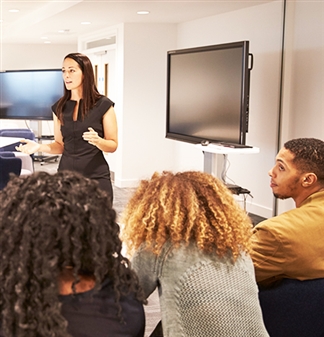
First impressions count, especially so in the education sector. The impression you leave on potential students and their parents is the ultimate deciding factor as to whether they choose your establishment over another. Here we look at specific areas of the 6th form and give guidance as to what students and parents will be looking out for in order to make their decision.

First impressions count, especially so in the education sector. The impression you leave on potential students and their parents is the ultimate deciding factor as to whether they choose your establishment over another.
Here we look at specific areas of the 6th form and give guidance as to what students and parents will be looking out for in order to make their decision.

General Teaching Rooms
Teaching methods have evolved since the days of the chalk board and classrooms have now progressed into a more active environment. Desks are less commonly set out in rows and instead, are now organised in such a way that students can interact with one and other. Trapezoidal classroom tables are useful for 6th forms, allowing lecturers to arrange the room in a way that's best suited to their teaching method.

Silent/Quiet Areas
When hand-in day is looming, students will often feel the need to seclude themselves from busy areas. Providing a silent study area will enable these students to completely focus on their work in peace. Use a variety of comfortable seating and avoid the use of group desks to deter any noisy groups from entering the area.

Reception Area
You'll be amazed Arguably, the reception area is the most important area within the establishment. This will usually be the first room in the 6th form that guests will see, so it needs to be impressive! Make it welcoming, use a vibrant colour scheme to promote enthusiasm, and remember that most 16 year olds will be looking for something interesting rather than dated and boring! Offer modern and comfortable seating and a spacious front desk that won't make the waiting area feel cramped and invasive. Provide tea and coffee making facilities so that your potential students feel a sense of maturity, and a coffee table or area full of literature for guests to browse through whilst they wait. Use any spare floor or wall space to display any awards the establishment and it's students have achieved.how much space you can free up by storing those annoying cables in a tray or tube! Grouping your cables together will provide you with more under-desk space and will lead (literally) to better comfort and concentration. Invest in a labeller. Spend some time labelling office drawers and storage compartments so that items aren't left lying around on desks/floors.

Library Layout
Now more commonly known as the 'Learning Resource Centre', this area of a 6th form is particularly important. Many students will use this area to quietly study as a means to escaping the busy study areas, so it's important that the facilities are of a high standard. As well as books, journals and other paper-based literature, the library is often the area in which the majority of the 6th forms computers will be located so it's important that students have can access them with ease. Provide spacious computer workstations so that students can type and write simultaneously, and offer double workstations for team work. Add a splash of colour to library shelving, desks and seats to provide a vibrant atmosphere for learning.

Study Areas
As another significant area of importance, study rooms need to be spacious and versatile in order to cater for various learning styles. These different areas should ideally be split up to minimise the chances of distraction, for example keeping the silent study area as far away from the performing arts practice area as possible. Use a range of comfy modular soft seating for students who find it easier to study in a relaxed environment and use traditional seating and desks for those who prefer to revise in a classroom scenario. In an age where group work is widely encouraged, it's important that students have access to areas in which they can work together comfortably. Use larger desks and group IT workstations to cater for this study style.

Performing Arts
Considering the rising number of performing arts students in recent years, it's important to provide practical and exciting facilities for both teachers and students. In general drama classrooms where space is limited, consider using a folding stages. Being able to fold away the stage when it's not needed will create additional space for activities. This facility will come in especially handy when putting on performances outside of the 6th form, in the local community for example.

Common Rooms
A common room is usually a space in which student can use during breaks or free-periods. Food and drinks (apart from water) are usually banned from these areas so the use of quirky,upholstered furniture is appropriate. Utilise the space available by using connecttables that students can push together, or pull apart as and when they need to.

Dining Areas
For many students, the transition from school to college or 6th form will mean meeting new people, and what better place to do so than the dining area? School dining tables are a great way of encouraging students to socialise during their breaks and are a more mature choice than the traditional school lunch bench. It's a good idea to add a number of smaller cafe/bistro style tables for students who are on shorter breaks or who prefer to sit alone and study during lunch breaks.